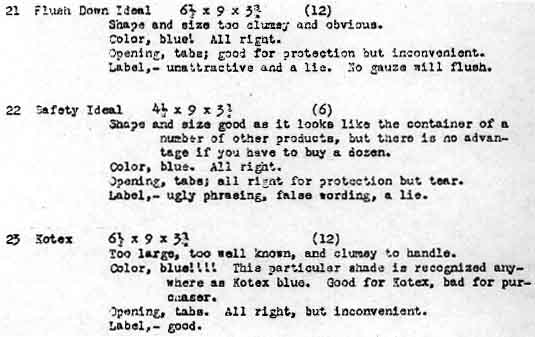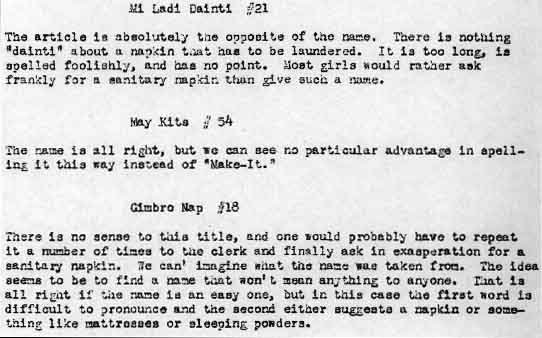See a roughly contemporary
pad, Society, and
a "silent purchase"
ad for Modess, 1928.
Other Modess ads:
1931,"Modess . . . . because"
ads, the French
Modess, and the German "Freedom"
(Kimberly-Clark) for teens.
See a prototype
of the first Kotex ad.


|

The perfect menstrual pad 2a (1 2 3 4 4a 5):
Using the right
names - and the color blue
"Report of Gilbreth,
Inc.," to the Johnson & Johnson
Company, 1 January 1927, about how to
improve the company's menstrual products,
especially with regard to competition with
Kotex pads
Dr. Gilbreth reviewed scores of
products that Johnson &
Johnson sent to her for
examination and comment, most of
which don't exist today. You will
get an idea of her style and
judgment from the excerpts, below;
she can be funny.
And if you ever wondered about
the color blue in
menstrual advertising - so did Dr.
Gilbreth, in 1927! Read her
comments in the excerpts toward
the bottom of this page. According
to "Shared Values: A History of
Kimberly-Clark" by Robert Spector
(1997) the Kotex blue is hospital blue
- I wonder what the origin of that
is. In a seemingly
not-well-thought-out rationale for
a menstrual product, blue in
American colloquial speech equating blue
with sad,
like the musical blues.
Names
If the company plans to
"extensively" and "intensively"
advertise the pad, then it needs
to use only one word, recommends
Gilbreth. If not, the words
"sanitary napkin" should be part
of the name. I added the red emphasis
on all Gilbreth's pages (below
and elsewhere).
1. "The name should be distinctive
so that there will be no
possibility of confusing it with
that of any other product." You
don't want the clerk to have to
ask, "The soap, perfume or
sanitary napkin?" Or, "What's
that?" requiring you to say what
is to be avoided in the first
place, "sanitary napkin." And
you don't want the clerk to have
to send you to another
department if the name is so
general that it can refer to
something else.
2. "It is better that the name
have no
significance at all
than be misleading or
suggestive. Venus [here]
and Charm are good brand names,
but used in connection with
sanitary napkins, have no point.
Flush Down Ideal, on the other
hand, is offensive, too
suggestive, and absolutely
misleading. . . .
"Kotex on these grounds is an
excellent name" but almost too
well known. "Recently a German
girl asked for kodaks [sic?]
[She probably means the Kodak
camera, but I didn't realize it
could be lower case - maybe it
was, being so common then] in a
shop and was promptly supplied
with a box of Kotex."
3. "Whatever the name, it
should be short
and capable of being easily
pronounced by any
customer and understood by any
clerk. Its sounds should be
definite and common to the
languages of all nations. In
Gimbro Nap [below], for example,
one cannot be sure whether the G
should be hard or soft. . . .
"Modess
is excellent, better than Kotex
in many ways as it is more
pleasing and feminine. It
suggests daintiness and
modishness, but nothing else.
Except for the first letter, it
has practically the same sounds
as Kotex, and if advertised as
widely, should not only derive
some benefit from that, but of
itself prove more appealing to
women."
I was
surprised to find dozens of typographic
errors - typos - in Dr.
Gilbreth's report. Many of them
were spaces after certain
letters in the middle of words,
something that used to happen
when the typist typed too fast.
Others I couldn't explain. None
seemed due to ignorance. I
wonder if people accepted typos
because of the known limitations
of the typewriter. [A reader
comments at the bottom
of this page.]
Some excerpts from Dr.
Gilbreth's scores of comments
follow.
The four
below deal with boxes: size, shape,
color, etc.
|
|

|
|

|
The color blue
obviously has a long history with
menstrual products; Dr. Gilbreth
does not explain why companies
chose it. The company history of
Kimberly-Clark called it hospital
blue for some reason.
|
The comments below are
about names of pads.
|

|
|

See how she rated
Johnson & Johnson's own Nupak
pads.
|
May Kits was a do-it-yourself
pad kit (Gilbreth
thought little of the materials
it provided), not popular
among college girls and working
women, who didn't have the time,
but high school kids still bought
them. The entry of women into the
marketplace after World War I must
have created a great demand for
pads that required less time; who
wanted to sit home washing pads at
night - and think of the logistics
of keeping used pads during the
day - and making new ones?
|
|
The copy of the report that I
read, which may be unique, rests
in the special collections of
Purdue University, West
Lafayette, Indiana, U.S.A. Dr.
Gilbreth was the first woman
engineering professor at Purdue.
© 2000
Harry Finley. It is illegal to
reproduce or distribute work on
this Web site in any manner or
medium without written
permission of the author. Please
report suspected violations to hfinley@mum.org
A
MUM visitor comments on
typewriters:
"I think yours is an interesting
question (Did people accept
typos?) and I wonder if you
realize how important the
historical context is here. If you
read Cheaper by the Dozen, you'll
know that the Gilbreth children
were early students of the
touch-typing method we take for
granted today. They were filmed
learning to type (on typewriters
with unmarked keys). So 1927 was
still relatively early days for
typewriting as a speed task. But
even when I first learned to type
(in the mid seventies, which was
after the development of the
electric typewriter), fixing
errors was still a horrendous job.
You had to stop typing, roll up
the platen and page to expose the
error, erase it, carefully realign
the page and type again. That
chore depended on sturdy paper and
a very abrasive specialized eraser
skinny enough to get in to the
characters without scrubbing out
neighbours. (Our erasers had
little brushes attached so we
could dust away the eraser
shavings rather than have them
fall into the workings of the
typewriter.) If you were using
carbon paper (another vanishing
technology) to make multiple
copies--this would have been
standard practice preparing a
report, I'm sure, so Dr. Gilbreth
could keep a copy for her own
files--then you had to erase on
each page, without pressing
against the interleaved carbon
paper. Sometimes, as a time
savings, you might make
corrections only on the top
("good") copy and leave the carbon
copies unaltered.
"The invention of White-Out made
a prettier page but took even
longer because we had to wait for
the cover-up to dry before rolling
the page back into the typewriter.
"So I imagine it would be
generally acceptable (efficient,
economical) to put up with some
typos in anything typewritten that
wasn't intended for printing."
Linda Carson
http://www.bigblackpig.com/
|
|